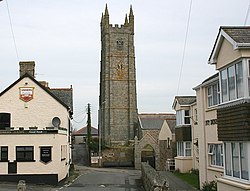St Columb Minor: Difference between revisions
Created page with '{{Infobox town |name=St Columb Minor |county=Cornwall |picture=St Columb Minor Church Tower - geograph.org.uk - 127957.jpg |picture caption=St Columba's Church |os grid ref=SW839…' |
|||
| Line 45: | Line 45: | ||
{{Reflist}} | {{Reflist}} | ||
* ''The St Columb Minor Parish and Church History and Calendar'', blotter of 1939-40 | * ''The St Columb Minor Parish and Church History and Calendar'', blotter of 1939-40 | ||
{{DEFAULTSORT:Saint Columb Minor}} | |||
Latest revision as of 22:31, 12 February 2013
| St Columb Minor | |
| Cornwall | |
|---|---|
 St Columba's Church | |
| Location | |
| Grid reference: | SW839622 |
| Location: | 50°25’14"N, 5°2’36"W |
| Data | |
| Postcode: | TR7 |
| Local Government | |
| Council: | Cornwall |
St Columb Minor is a village near the north coast of Cornwall, at the ege of Newquay. At one time St Columb Minor used to be the main village in the area, but it has now been encroached upon by its larger neighbour Newquay. St Columb Major is some miles further east, inland.
The National School in the Square was built in 1842. It is on the site of the Parsonage and is now used as a Men's Institute.
Parish Church
The Parich Church is St Columba's, named for a local saint, a lady, not the more famous Irish warrior saint of Iona.
The western end of the church and yard is in view of the Trevalgue clifftop twin tumuli, known locally as The Barrows. It is sheltered from the strong winds of the Atlantic and looks down the Rialton Valley and across to Castle-an-Dinas. Local legend has it that the Welsh missionaries, centuries before the Columba legend arose, drove away the evil spirits and replaced pagan magic by Christian worship, and erected a wooden sanctuary.
The church-town lay to the west and south while the shelving ground to the north and east prevented building. Hence, as in the case of so many villages, development in the 20th century extended further from the parish church, in this case towards Porth Bean and Henver Roads, leading into Newquay.
History
In Celtic and Anglo-Saxon times Rialton was the head manor of the Pydarshire Hundred and belonged to the monks of St Petroc at Bodmin. The monastery remained in possession after the Norman Conquest and a manor house was built here by Prior Vivian (Thomas Vivian, titular Bishop of Megara) ca. 1510. The manor passed to the Duchy of Cornwall in 1538 but some of the manor house remains.[1]
Residents Association
St Columb Minor Residents Association was formed in 2009 by a group of volunteers following an official invitation to all residents to attend a PACT (Police and Communities Together) meeting in St Columb Minor Church Hall.
The aim of the association is to promote, uphold and represent the rights, interests and welfare of residents, and to protect and advance amenities and promote a sense of community spirit.
See also
Outside links
| ("Wikimedia Commons" has material about St Columb Minor) |
- St Columb Minor website with details of the Church and Parish
- Cornwall Record Office Online Catalogue for St Columb Minor
References
- ↑ Cornish Church Guide (1925) Truro: Blackford; pp. 76-77
- The St Columb Minor Parish and Church History and Calendar, blotter of 1939-40
